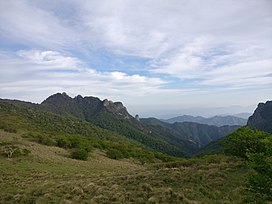
Back تشينلينج ARZ Цыньлін Byelorussian Цинлин Bulgarian Quinling Catalan Qin Ling CEB Čchin-ling Czech Qinling Danish Qin Ling German Cordillera Qin Spanish Qinling Estonian
| Qinling | |||||||||
|---|---|---|---|---|---|---|---|---|---|
 | |||||||||
| Highest point | |||||||||
| Peak | Mount Taibai | ||||||||
| Elevation | 3,767 m (12,359 ft) | ||||||||
| Coordinates | 33°57′48″N 107°37′05″E / 33.96333°N 107.61806°E | ||||||||
| Naming | |||||||||
| Language of name | |||||||||
| Chinese name | |||||||||
| Traditional Chinese | 秦嶺 | ||||||||
| Simplified Chinese | 秦岭 | ||||||||
| Literal meaning | Qin Peak(s) | ||||||||
| |||||||||
| Former name is Southern Mountains | |||||||||
| Chinese | 南山 | ||||||||
| |||||||||
| Geography | |||||||||
| Country | |||||||||
| Region | Southern Shaanxi Province | ||||||||
The Qinling (Chinese: 秦岭) or Qin Mountains, formerly known as the Nanshan ("Southern Mountains"), are a major east–west mountain range in southern Shaanxi Province, China. The mountains mark the divide between the drainage basins of the Yangtze and Yellow River systems, providing a natural boundary between North and South China and support a huge variety of plant and wildlife, some of which is found nowhere else on earth.
To the north is the densely populated Wei River valley, an ancient center of Chinese civilization. To the south is the Han River valley. To the west is the line of mountains along the northern edge of the Tibetan Plateau. To the east are the lower Funiu and Dabie Mountains, which rise out of the coastal plain.
The northern side of the range is prone to hot weather, the rain shadow cast by the physical barrier of the mountains dictating that the land to the north has a semi-arid climate, and is consequently somewhat impoverished in regard to fertility and species diversity.[1] Furthermore, the mountains have also acted in the past as a natural defense against nomadic invasions from the north, as only four passes cross the mountains. In the late 1990s a railway tunnel and a spiral were completed, thereby easing travel across the range.[2]
The highest mountain in the range is Mount Taibai at 3,767 meters (12,359 ft), which is about 100 kilometers (62 mi) west of the ancient Chinese capital of Xi'an.[3] Three culturally significant peaks in the range are Mount Hua (2,155 meters or 7,070 feet), Mount Li (1,302 meters or 4,272 feet), and Mount Maiji (1,742 meters or 5,715 feet).

- ^ World Wildlife Fund, ed. (2001). "Qinling Mountains deciduous forests". WildWorld Ecoregion Profile. National Geographic Society. Archived from the original on 2010-03-08. Retrieved 17 December 2007.
- ^ Wallis, Shani (October 1, 1999). "Qinling Breakthroughs". World Tunnelling. Archived from the original on 2011-05-16. Retrieved 2007-12-17 – via Highbeam Research.
- ^ "Qinling Mountains". Bookrags.com. Retrieved 17 December 2007.

